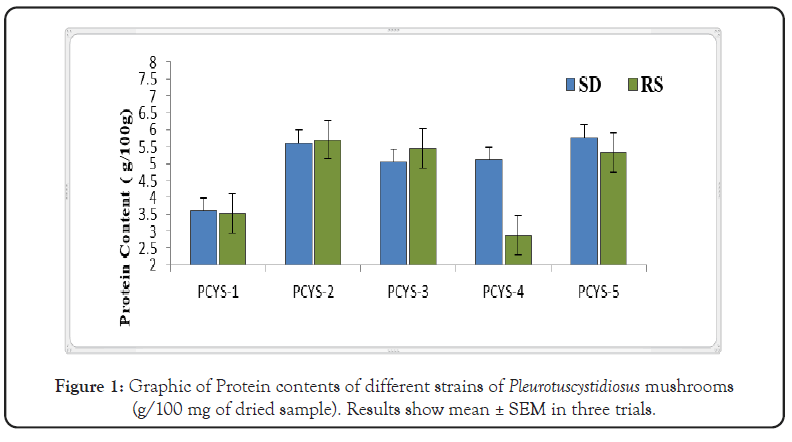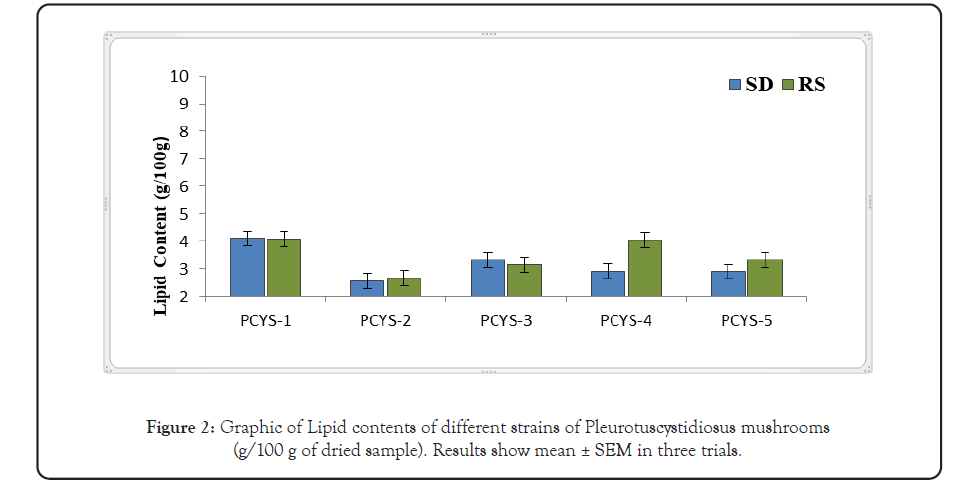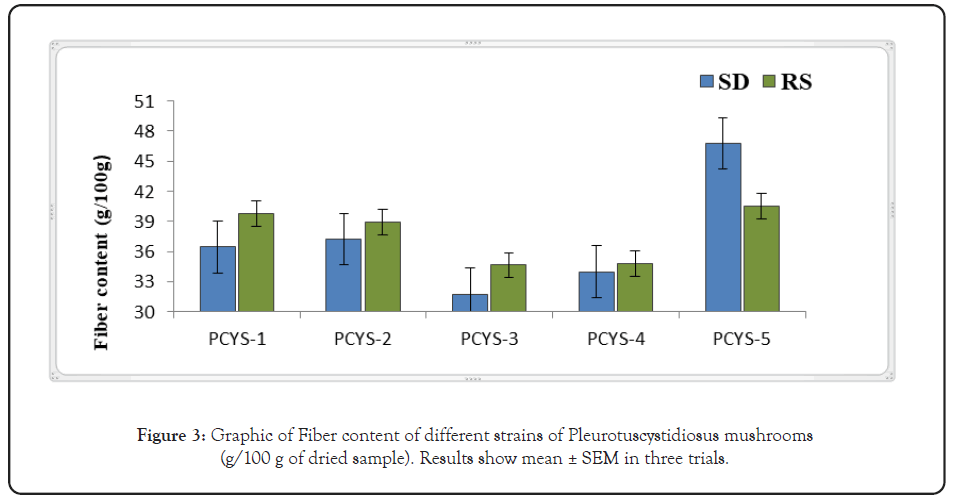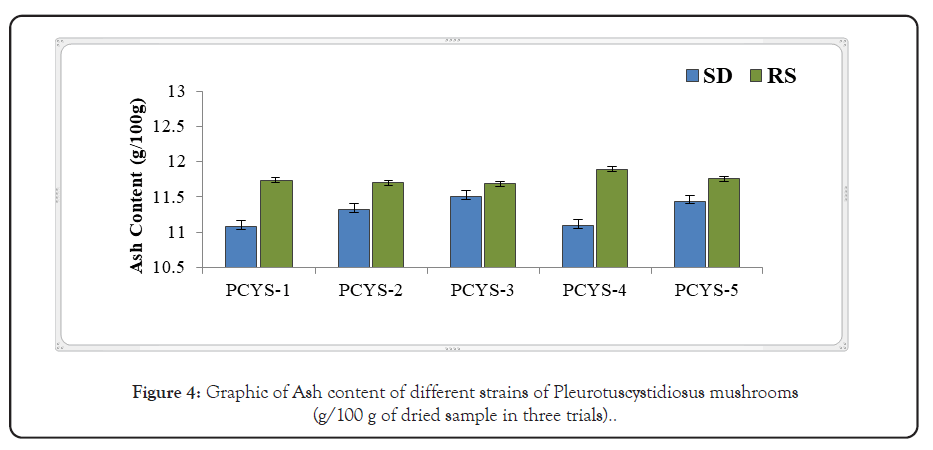Fungal Genomics & Biology
Open Access
ISSN: 2165-8056
ISSN: 2165-8056
Research Article - (2021)Volume 11, Issue 3
Background: Maple oyster mushroom (Pleurotuscystidiosus) has been gaining culinary popularity in different countries of the world. In Bangladesh mushroom markets; this mushroom stands a lucrative position with regard to consumer demand. Unfortunately, excessive production of P. cystidiosus has received little attention. Thus, in our previous studies, we showed the comparative effect of Saw Dust (SD) and Rice Straw (RS) on yield of different strains of Pleurotuscystidiosus (PCYS1-5). In the current experiment, we have evaluated the comparative nutritional values of different strains of P. cystidiosus (PCYS1-5).
Methods: Standard protocols have been followed to evaluate the nutritional contents i.e. carbohydrates, proteins, lipids, ash and crude fiber contents of different strains of P. cystidiosus.
Results: Among the five strains (PCYS1-5), the highest carbohydrate and lipid content had been observed for PCYS1 (48.41% and 5.64%, respectively). Highest protein and crude fiber content had been observed in PCYS1 (5.76% and 46.76%, respectively).
Conclusion: Pleurotuscystidiosus stands as an important culinary and nutritional supplement and its production and distribution could be accelerated for the malnourished population of Bangladesh and of the rest of the world.
Biomolecules; Food supplement; Mushroom; Mycology; Nutraceutical; Nutrition
The genus Pleurotus, belonging to the family Tricholomataceae, is the second mostly cultivated culinary mushroom, following Agaricusbisporus, in the world [1]. Cultivation of Pleurotus in Asian countries surpasses that of other mushrooms and there remains ever increasing demand for high yield for the sake of low cost [2]. Thus, search for low-cost techniques and technologies have received lofty concern in mushroom research and development academia and industries. In Bangladesh, rice straw and saw dust are easily available substrates for mushroom cultivation. As composition, quality, quantity and ratio of different substrates and impact the production of different mushroom species highly, a standard protocol for cultivation of P. cystidiosus, especially for the Bangladeshi mushroom growers, would benefit mushroom industries and associated pharma and nutraceutical industries as well as national economy immensely [3,4]. In fact, P. cystidiosus is among the least reported mushroom species in regard of yield and nutrition-based information [5]. Though other species of Pleurotushave received high attention in regard of cultivation in Bangladeshi perspective, P. cystidiosus has received the opposite [6]. Thus, the present study had been aimed at determining the nutritional status of different strains of P. cystidiosus mushroom (named arbitrarily as PCYS 1-5) grown on Rice Straw (RS) and Saw Dust (SD) based substrates.
The experiment had been carried out at the Department of Biochemistry and Molecular Biology, Jahangirnagar University and at the Mushroom Development Institute, Savar, Dhaka, Bangladesh from June to December, 2019. Nutritional assessments had been performed following the procedure established by the Association of Official Analytical Chemists (AOAC) [7]. Analyses included the determination of crudeprotein, crude fat, ash, crude fiber, moisture and carbohydrate. The percentage of all the fractions (crude protein, crude fat andash) were added together and subtracted from 100 to obtain the total carbohydrate percentage.
As composition, quality, quantity and ratio of different substrates and impact the production of different mushroom species highly, a standard protocol for cultivation of P. cystidiosus, especially for the Bangladeshi mushroom growers, would benefit mushroom industries and associated pharma and nutraceutical industries as well as national economy immensely. In fact, P. cystidiosus is among the least reported mushroom species in regard of yield and nutrition-based information. Though other species of Pleurotus have received high attention in regard of cultivation in Bangladeshi perspective, P. cystidiosus has received the opposite. Thus, the present study had been aimed at determining the nutritional status of different strains of P. cystidiosus mushroom (named arbitrarily as PCYS 1-5) grown on Rice Straw (RS) and Saw Dust (SD) based substrates.
The rest of the treatments varied significantly over control. The result of the present study showed that the lipid content of different strain of PCYS mushroom is decreased when grown on sawdust in comparative with when grown on rice straw. The result of the present study keeps pace with the findings, who found 0.4-5.00% lipid in oyster mushroom varieties. Alam et al. reported 4.30 to 4.41% lipids in oyster mushroom grown on different substrates. Though information regarding lipid content of PCYS is scarce, lipid content of P.ostreatus had been reported to be in the same range as that of ours.
Nutritional content of different strains of P. cystidiosus
Protein: The protein content of different strains of Pleurotus cystidiosus mushrooms is shown in Table 1. All the treatments contain a considerable amount of protein. The content of protein varied from 2.88-5.76% (w/w) in the mushroom grown on sawdust and rice straw. The highest content of protein was found in treatment PCYS-5+SD (5.76%) and the lowest protein was found in PCYS-4+RS (2.88%). The other treatments varied significantly over control in respect to protein content (Table 1). The result of the present study corroborates with the study of Mudakir et al. who reported that PCYS oyster mushrooms contained 1.59-2.71% protein [8]. Thus, PCYS could be a good source of protein for daily intake. The vegetarians usually suffer from the shortage of proteins. Inclusion of PCYS in the vegan diet would meet their demand for proteins. Mushroom proteins are rich sources of essential amino acids also [9]. Mushroom proteins’ content of essential amino acids is almost the same as those of the animal proteins [9]. Also, mushroom-based “meat analogues” taste almost like those of animal meat that would be of choice for the vegetarian and those wondering for weight reductive diets [10] (Figure 1).

Figure 1: Graphic of Protein contents of different strains of Pleurotuscystidiosus mushrooms (g/100 mg of dried sample). Results show mean ± SEM in three trials.
| Substrates | Strain | ||||
|---|---|---|---|---|---|
| PCYS-1 | PCYS-2 | PCYS-3 | PCYS-4 | PCYS-5 | |
| SD | 3.6 ± 0.23a | 5.6 ± 0.47a | 5.04 ± 0.32a | 5.1 ± 0.36a | 5.76 ± 0.42a |
| RS | 3.52 ± 0.15a | 5.7 ± 0.39b | 5.44 ± 0.17a | 2.88 ± 0.57a | 5.33 ± 0.25a |
*Results show mean ± SEM in three trials. Values in the same column that do not share a common superscript are significantly different at P ≤ 0.05 (Duncan’s multiple range test).
Table 1: Protein content of different strains of Pleurotuscystidiosus mushrooms (g/100g of dried sample).
Lipid
The lowest lipid percentage was counted under treatment PCYS- 2+SD (2.55%) and the highest lipid percentage was counted under PCYS-2+RS (5.64 %). The lipid content of different strains of P. cystidiosus mushrooms is shown in Table 2. The rest of the treatments varied significantly over control (Table 2). The result of the present study showed that the lipid content of different strain of PCYS mushroom is decreased when grown on sawdust in comparative with when grown on rice straw. The result of the present study keeps pace with the findings, who found 0.4-5.00% lipid in oyster mushroom varieties [8]. Alam et al. reported 4.30 to 4.41% lipids in oyster mushroom grown on different substrates [11]. Though information regarding lipid content of PCYS is scarce, lipid content of P. ostreatus had been reported to be in the same range as that of ours (Figure 2).

Figure 2: Graphic of Lipid contents of different strains of Pleurotuscystidiosus mushrooms (g/100 g of dried sample). Results show mean ± SEM in three trials.
| Substrates | Strain | ||||
|---|---|---|---|---|---|
| PCYS-1 | PCYS-2 | PCYS-3 | PCYS-4 | PCYS-5 | |
| SD | 4.1 ± 0.24a | 2.55 ± 0.30a | 3.31 ± 0.13a | 2.92 ± 0.22a | 2.886 ± 0.23a |
| RS | 4.09 ± 0.38a | 2.65 ± 0.43b | 3.14 ± 0.33a | 4.05 ± 0.31b | 3.324 ± 0.31a |
*Results show mean ± SEM in three trials. Values in the same column that do not share a common superscript are significantly different at P ≤ 0.05 (Duncan’s multiple range test).
Table 2: Lipid content of different strains of Pleurotuscystidiosus mushrooms (g/100g of dried sample.)
Crude fiber
The crude fiber content of different strains of Pleurotus cystidiosus mushrooms is shown in Table 3.The highest percentage of crude fiber was counted under treatment PCYS-5+SD (46.756%) and the lowest crud fiber percentage was counted under PCYS-3+SD (31.738%). The rest of the treatments were statistically different but varied significantly over control in respect to percent crud fiber content (Table 3). The findings of the present study corroborate with the study Amin et al. reported 25.5 ± 1.7 of fiber in PCYS [10]. Tolera et al. reported that different processing techniques and condition as well as environmental factors greatly affect the fiber content of Pleurotus mushrooms [12-14] (Figure 3).

Figure 3: Graphic of Fiber content of different strains of Pleurotuscystidiosus mushrooms (g/100 g of dried sample). Results show mean ± SEM in three trials.
| Substrates | Strain | ||||
|---|---|---|---|---|---|
| PCYS-1 | PCYS-2 | PCYS-3 | PCYS-4 | PCYS-5 | |
| SD | 36.43 ± 0.23a | 37.23 ± 0.56a | 31.73 ± 0.34a | 33.96 ± 0.87a | 46.75 ± 0.39ab |
| RS | 39.78 ± 0.34b | 38.88 ± 0.41a | 34.62 ± 0.12a | 34.74 ± 0.65a | 40.53 ± 0.54a |
*Results show mean ± SEM in three trials. Values in the same column that do not share a common superscript are significantly different at P≤0.05 (Duncan’s multiple range test).
Table 3: Fiber content of different strains of Pleurotuscystidiosus mushrooms (g/100g of dried sample)
Ash
The ash content of different strains of Pleurotus cystidiosus mushrooms is shown in Table 4. The highest percentage of ash was counted under treatment PCYS-4+RS (11.89%) and the lowest ash percentage was counted under PCYS-1+SD (11.08%). The rest of the treatments were statistically different but varied significantly over control in respect to percent ash content. The findings of the present study corroborate with the study Amin et al. reported 7.5 ± 0.7 % of ash in PCYS. Our findings are also in concordance with those of, who reported that processing and environmental conditions affect the content and quality of ashes in Pleurotus mushrooms [12-14] (Table 4) (Figure 4).

Figure 4: Graphic of Ash content of different strains of Pleurotuscystidiosus mushrooms (g/100 g of dried sample in three trials)..
| Substrates | Strain | ||||
|---|---|---|---|---|---|
| PCYS-1 | PCYS-2 | PCYS-3 | PCYS-4 | PCYS-5 | |
| SD | 11.08 ± 1.4a | 11.32 ± 2.3a | 11.5 ± 0.89a | 11.09 ± 2.33b | 11.44 ± 1.77a |
| RS | 11.74 ± 2.3a | 11.7 ± 1.8b | 11.69 ± 1.65a | 11.89 ± 1.56a | 11.76 ± 2.50a |
*Results show mean ± SEM in three trials. Values in the same column that do not share a common superscript are significantly different at P ≤ 0.05 (Duncan’s multiple range test).
Table 4: Ash content of different strains of Pleurotuscystidiosus mushrooms (g/100g of dried sample).
Carbohydrate
The carbohydrate content of different strains of Pleurotus cystidiosus mushrooms is shown in Table 5. The lowest percentage of carbohydrate was counted under treatment PCYS-5+SD (33.158%) and the highest carbohydrate percentage was counted under PCYS-3+SD (48.412%). The rest of the treatments were statistically different but differed significantly over control in respect to percent carbohydrate content (Table 5). The findings of the present study matches with the study of Amin et al. reported that PCYS mushrooms contained 44 ± 1.6% of carbohydrates [14] (Figure 5).
| Substrates | Strain | ||||
|---|---|---|---|---|---|
| PCYS-1 | PCYS-2 | PCYS-3 | PCYS-4 | PCYS-5 | |
| SD | 44.784 ± 3.6a | 43.292 ± 2.5a | 48.412 ± 2.6a | 46.928 ± 1.85a | 33.158 ± 2.45a |
| RS | 40.862 ± 2.7a | 38.074 ± 3.9a | 45.106 ± 1.8a | 44.092 ± 2.36a | 39.052 ± 1.23b |
*Results show mean ± SEM in three trials. Values in the same column that do not share a common superscript are significantly different at P ≤ 0.05 (Duncan’s multiple range test).
Table 5: Carbohydrate content of different strains of Pleurotuscystidiosus mushrooms (g/100g of dried sample).
Among the five strains of P. cystidiosus (PCYS1-5) under the present experiment, the PCYS2 (PCYS-2+SD) had been observed possessing the best nutritional content. Thus, PCYS2 could be provided as the nutritional supplement in different culinary, medicinal and therapeutic approaches.
Adeclaration
Not applicable.
Consent for publication
All authors consented to publish.
Availability of data and material
Not applicable.
This study had been performed utilizing the grant-in-aid from Jahangirnagar University, Dhaka, Bangladesh for the fiscal year 2020-2021.
Mohammad Azizur Rahman gratefully acknowledge the financial support provided by the Jahangirnagar University, Bangladesh; laboratory and equipment support by the Bangladesh Mushroom Development Institute, Ministry of Agriculture, Government of the People’s Republic of Bangladesh.
Mohammad Azizur Rahman and Akhter Jahan Kakon designed the experiment. Mohammad Azizur Rahman prepared the manuscript. Umme Habiba edited the manuscript. Other authors conducted the research activities and collected data
Citation: Rahman MA, Mia R, Bashir NMB, Hossain A, Saha SK, Habiba U, et al. (2021) Determination of Nutritional Value of Different Strains of Pleurotuscystidiosus Mushroom. Fungal Genom Biol. 11:170.
Received: 02-Jul-2021 Accepted: 16-Jul-2021 Published: 23-Jul-2021 , DOI: 10.35248/2165-8056.21.11.170
Copyright: © 2021 Rahman MA, et al. This is an open-access article distributed under the terms of the Creative Commons Attribution License, which permits unrestricted use, distribution, and reproduction in any medium, provided the original author and source are credited.